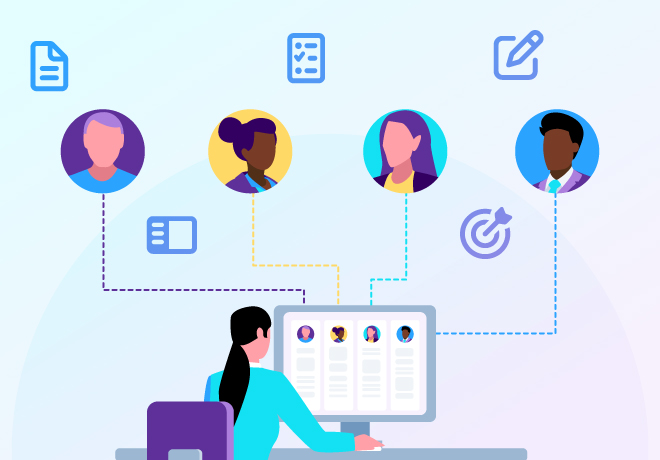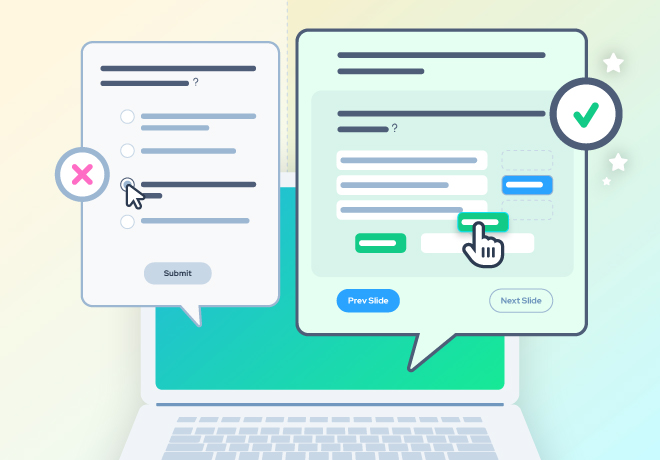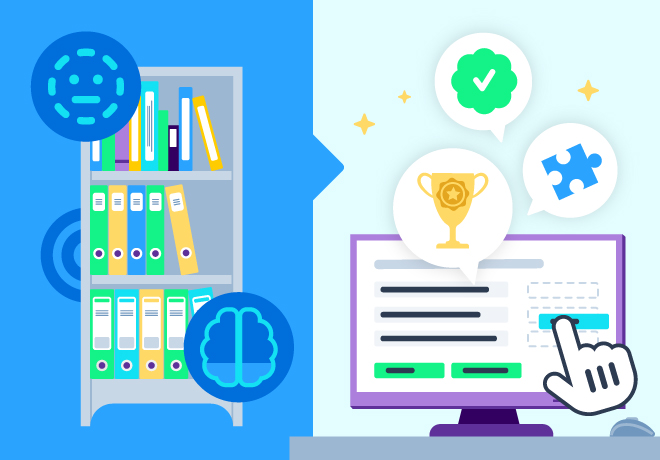
What is learning analytics?

Related articles
Get valuable eLearning insights to your inbox.
Listen to Neovation’s Demystifying eLearning podcast generated with NotebookLM!
Listen to our podcast on your favorite platform!
Imagine trying to use a cookbook that didn’t include measurements. Every dish would be a guaranteed disaster until you accidentally found the right ratios of ingredients to produce an edible dish. The measurement of each ingredient is the entire purpose of the cookbook. Some of us may have learned how to eyeball ingredients for a few tried and true family recipes (Thanks, Nanna!). A rare few of us may be gifted enough to instinctively know how to put together a complex dish without measuring anything (a pinch of this and a wee bit of that!) Outcomes are not guaranteed.
Generally speaking, we need measurements to ensure success.
So does your corporate online training program.
Your online corporate training program is like that cookbook. It might take some time to find the recipe that you like best. You put together the right ingredients in the right order to produce the desired result – changes in the behavior of your employees that move your KPIs for things like
- reduced job-site accidents,
- higher sales per labor hour,
- more productive output on your factory floor,
- better customer service ratings,
whatever your corporate learning or training ROI goals may be.
Here’s what we’ll be covering in this article:
- What is learning analytics?
- Learning analytics and online training software
- Types of data collected by learning analytics
- What training administrators need to look for in their analysis to improve KPIs
- How personalization comes into play when examining learning analytics
- Learning analytics and eLearning content or training courses
- Learning analytics is essential to your eLearning program’s success
To maximize your chances of serving a successful dish to your food critics (okay – successful outcomes to your decision-makers and KPI-keepers), you need to measure and analyze your online training based on empirical data. Learning analytics gives you access to the data ingredients you need to improve your training outcomes.
What is learning analytics?
Learning analytics is a rapidly growing field that describes the measurement, collection, analysis, and reporting of data about learners and their interaction with your training courses. Its goal is to provide you with the data you need to help you understand how your learners are doing and then illuminate the steps you may need to take to optimize learning and knowledge retention. Analytics also provides insight into the day-to-day learner engagement with your training platforms and can expose areas of improvement for your course content.
In the world of online corporate training, also often referred to as “learning and development,” learning analytics are increasingly being used to help training managers, course creators, and program administrators make informed decisions about instructional design, course delivery, and learner assessment. This is one place where there cannot be too many cooks stirring the soup – you need inputs from all areas of your L&D program to ensure a successful outcome for all involved. You do need a Chef du Cuisine – one person who is the ultimate decision-maker to keep everything aligned. Job titles vary, but think CTO – Chief Training Officer or Director of Training – who keeps all the pots bubbling and who acts as quality control on the entire process (think of a better-mannered, more softly-spoken Gordon Ramsay.)
Learning analytics and online training software
Any training platform worth its salt should have a robust built-in analytics suite that is easy to understand and use by those of us who are not data scientists, as its goal is to provide you, the training manager or administrator, with all the data you need to analyze, make decisions, and take action. Two of the most commonly used types of training software are learning management systems (LMS) and microlearning platforms.
Your learning management system (LMS)
An LMS is a software application that manages and delivers educational courses, training programs, or learning and development programs to your remote or online users. An LMS allows organizations to manage and track employee training and development and monitor and evaluate their training programs' effectiveness. In recent years, the use of LMS has become increasingly popular as organizations look for ways to improve the efficiency and effectiveness of their training programs.

Sizzlin’ Hot Stat: Between 70 and 75% of all businesses in North America are using some form of learning management system to educate their teams, according to various studies and surveys by reputable organizations like Software Advice and the eLearning Industry Association
One of the key benefits of using an LMS is the ability to track and analyze data about your learners, such as their engagement, performance, and progress. This information can then be used to inform decisions about instructional design, delivery, and assessment and evaluate the effectiveness of your training programs.
Your microlearning platform
Microlearning technology is a type of learning and development technology that provides short focused, and highly targeted learning experiences. Microlearning is typically delivered in short, bite-sized chunks of information, such as videos, quizzes, or short articles, and is designed to be consumed in a few minutes or less. Think of it this way – training as snack food for the hungry mind.
Microlearning aims to provide learners with just-in-time information that they can quickly apply to their work, rather than lengthy courses or training programs that take hours or days to complete. Microlearning platforms often include gamification elements, with leaderboards, contests, and rewards systems, and deliver training in a mobile-ready interface.

Microlearning is an important part of the larger trend toward personalized and adaptive training. It is particularly well-suited to online corporate training, where employees often have limited time and attention to devote to learning and development. By providing targeted, bite-sized learning experiences, microlearning technology helps ensure your learners can quickly apply the information they need to their work.
Learning analytics in LMS and microlearning technology
Learning analytics are an important part of both LMS and microlearning technology, as they provide organizations with valuable information about the effectiveness of their training programs. Each platform can track data about your learners, such as their engagement, performance, and progress, and use that information to inform your instructional design, delivery, and assessment decisions. You can identify areas where your training programs may fall short and make changes that can improve the effectiveness of the programs.
Truly adaptive microlearning technology can use learning analytics to track your learners’ engagement, performance, and progress data and use that information to provide them with personalized and adaptive customized learning experiences. For example, suppose a learner is struggling with a particular topic. In that case, microlearning technology can provide additional resources or opportunities to practice and learn only those areas where the learner needs improvement – as soon as the learner demonstrates they are sliding down the forgetting curve for that topic.
Types of data collected by learning analytics
Here are some of the types of data you should be able to collect from almost any learning management system or microlearning platform. Because microlearning offers daily training, those numbers may be more volatile than in a standard LMS, as every daily training session will influence them. These analytics can give you a real-time view of some of these metrics.
Learner engagement analytics
Most platforms can track data on how much time your learners spend on each module, how many times they access the module, and how many modules they complete. This information can provide insight into which modules are engaging and which are not, allowing your training administrators to make changes to improve engagement and completion rates.
Training performance analytics
Almost all online training platforms can track data on the results of assessments and quizzes, including the number of correct answers, completion times, and scores. This information can help your training administrators to identify areas where your learners are struggling and to design additional resources, performance supports, or activities to support learning.
Progress metrics
Every type of learning software should be able to track the progress of your individual learners through their training program, including the number of modules completed, the time it takes to complete each module, and the overall completion rate. This information can help your training administrators to identify areas where learners are struggling and to make changes to improve completion rates.
What training administrators need to look for in their analysis to improve KPIs
We’re planning to write many more articles to drill down into the relationships between specific learning analytics and their influence on KPIs, so for this article, I’ll give you a high-level summary of what to watch for, so you can get started right away in working more deeply with your learning analytics output.

KPIs to watch for with learner engagement analytics
Training administrators should look for trends in the amount of time your learners spend on each module, the number of times they access the module, and the number of modules they complete. If engagement is low in certain modules, your training administrators should consider making changes to improve engagement and completion rates.
Training performance KPIs to keep your eye on
Training administrators should look for trends in the results of assessments and quizzes, including the number of correct answers, completion times, and scores. If your learners struggle in certain areas, the training administrator should consider designing additional resources or activities to support learning. Sometimes the questions need to be revised or improved.
Trends for learner progress metrics to be mindful of
Training administrators should look for trends in the progress of individual learners through their training program, including the number of modules completed, the time it takes to complete each module, and the overall completion rate. If learners struggle to complete specific modules or the overall training program, the training administrator should consider making changes to improve completion rates.
How personalization comes into play when examining learning analytics
Training administrators should look for trends in the specific needs and preferences of individual learners, such as their learning style, preferred learning pace, and the types of microlearning modules they are most likely to engage with. Use this information to provide personalized and adaptive learning experiences that meet the specific needs of each learner.
Learning analytics helps you, the training manager or administrator, measure the effectiveness of your training programs and can help them to make data-driven decisions to improve engagement, performance, and completion rates. By analyzing data on learner engagement, performance, progress, and personalization, training administrators can identify areas for improvement and take action to increase their training programs' overall impact and success.
To maximize the value of learning analytics, your training administrators should be proactive in seeking out relevant data and using it to drive improvements. Review analytics reports regularly, using tools and dashboards that provide clear and actionable insights and incorporating data analysis into their day-to-day work processes.
In addition to improving KPIs, learning analytics can provide insights into the overall learner experience, including what works well, and reveal what needs improvement. Use this information to create a more engaging and effective training program focusing on the target audience's specific needs and preferences. Learning analytics can help training administrators to create more effective and impactful training programs and to drive better results for their organization.
Learning analytics and eLearning content or training courses
Similarly, we could write an entire book on learning analytics to collect and evaluate when it comes to your eLearning content or training courses. Like your learning platform, how your learners experience your training platform plays a role in their ability to retain knowledge and recall it when the need arises. Specifically, as a starting point, learning analytics can help improve your training course content in several ways.

Learner interaction analytics
By analyzing data on how your learners interact with the training course, including which modules are most frequently accessed, how much time is spent on each module, and which modules are most engaging, training administrators can identify areas for improvement and make changes to enhance the learner experience.
Knowledge retention analytics
Data on the results of assessments and quizzes can provide insight into which topics learners are retaining and which they are struggling with. Based on this information, training administrators can modify the training course content to focus on areas that need improvement and ensure learners retain the most important information.
Learner feedback analytics
By analyzing data on learner feedback, including surveys and ratings, training administrators can identify areas of the training course that need improvement and make changes to meet learners' specific needs and preferences. You’ll get a more engaging and effective training experience and improved knowledge retention based on making informed decisions and effective changes.
Personalization metrics
By analyzing data on individual learners' specific needs and preferences, training administrators can create a more personalized learning experience that meets the unique needs of each learner. You should start to see better engagement and improved learning outcomes.
By using learning analytics to gather and analyze data on learner interaction, knowledge retention, learner feedback, and personalization, training administrators can make informed decisions about how to improve their training course content. Taking action based on deep analysis can result in a more effective and impactful training experience, with improved learner engagement, knowledge retention, and overall outcomes.
Learning analytics is essential to your eLearning program’s success
Learning analytics are an important part of online corporate training and learning and development and are increasingly used to inform decisions about instructional design, delivery, and assessment. LMS and microlearning technology are two of the most critical areas where learning analytics are being applied, as they provide organizations with valuable information about the effectiveness of their training programs.
Unfortunately, so many people are afraid of data – like many cooks are afraid of new recipes, sticking to what they instinctively “know” – which does not improve their culinary skills. Ignore your analytics, and over time, your training program will suffer. Your learners will go hungry – for great training and be less happy in their roles. Embrace the fear, and learn to love your learning analytics. It will help you anticipate problems by illuminating them before they become critical and help you solve known challenges by confirming your improvements are moving in the right direction.
By using learning analytics to track data about your learners, you can ensure that their training programs are delivering the right information at the right time and in the right way to improve the program’s effectiveness and support employee learning and development. If you're interested, take your metrics to the next level and read articles about how you can use learning analytics to calculate training ROI – to show the payoff of your investment in your online training program. And that is a “Chef’s Kiss” of great L&D teams – getting the measurements right and producing engaging, effective online training for your team’s eager consumption. Bon Appetit!

With 15+ years of online marketing and online learning experience, Susan loves to share insights about where these two ROI-building practices can intersect and complement each other for your business or organization.
Become part of our L&D community
We publish a new learning hub article — full of useful, practical topics — weekly.
Not sure where where you want to start? Jump into one of our recently published articles and see where it takes you!








-svg.svg)
-svg.svg)
-svg.svg)
-svg.svg)